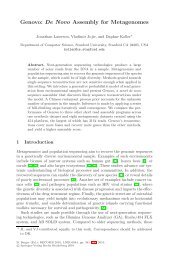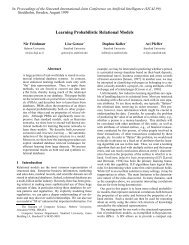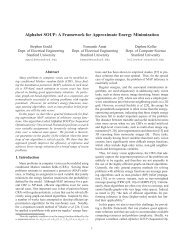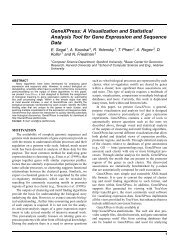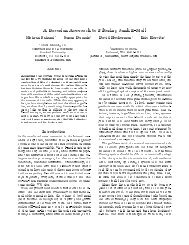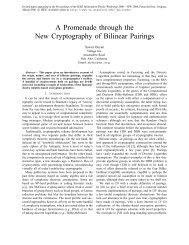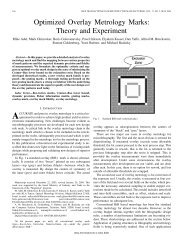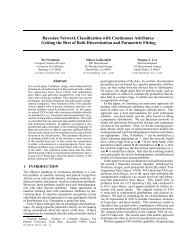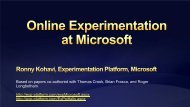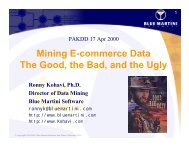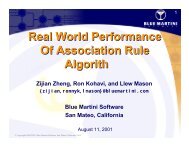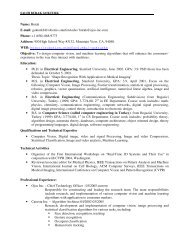Heart rate (residual) - Stanford University
Heart rate (residual) - Stanford University
Heart rate (residual) - Stanford University
Create successful ePaper yourself
Turn your PDF publications into a flip-book with our unique Google optimized e-Paper software.
Several extensions of LDA that model additional structure in the data [19, 20, 12] can add to the<br />
expressiveness of TSTMs. In particular, modeling disease composition over time (analogous to<br />
[19]) and disease evolution within a single patient (analogous to [20]) should provide interesting<br />
insight. We leave these next steps for future work.<br />
References<br />
[1] Y. Bar-Shalom and T. E. Fortmann. Tracking and Data Association. Academic Press Professional,<br />
Inc., 1987.<br />
[2] D. Blei, A. Ng, and M. Jordan. Latent Dirichlet allocation. In J. Mach. Learn. Res. 2003.<br />
[3] E. Fox, E. Sudderth, M. Jordan, and A. Willsky. The sticky HDP-HMM: Bayesian nonparametric<br />
hidden Markov models with persistent states. Technical Report P-2777, MIT LIDS,<br />
2007.<br />
[4] E. Fox, E. Sudderth, M. Jordan, and A. Willsky. Nonparametric Bayesian learning of switching<br />
linear dynamical systems. In NIPS. 2008.<br />
[5] E. Fox, E. Sudderth, M. Jordan, and A. Willsky. Sharing features among dynamical systems<br />
with Beta Processes. In NIPS. 2009.<br />
[6] M. Griffin, D. Lake, E. Bissonette, F. Harrell, T. O’Shea, and J. Moorman. <strong>Heart</strong> <strong>rate</strong> characteristics:<br />
novel physiomarkers to predict neonatal infection and death. In Pediatrics. 2005.<br />
[7] T. Griffiths and M. Steyvers. Finding scientific topics. In PNAS. 2004.<br />
[8] H. Ishwaran and M. Zarepour. Exact and approximate sum-representation for the Dirichlet<br />
process. In Canadian Journal of Statistics. 2002.<br />
[9] T. Joachims. Training linear SVMs in linear time. In KDD. 2006.<br />
[10] K. Kurihara, M. Welling, and Y. W. Teh. Collapsed variational Dirichlet process mixture<br />
models. In IJCAI, 2007.<br />
[11] H. Lee, Y. Largman, P. Pham, and A. Ng. Unsupervised feature learning for audio classification<br />
using convolutional deep belief networks. In NIPS, 2009.<br />
[12] W. Li and A. McCallum. Pachinko Allocation: DAG-structured mixture models of topic correlations.<br />
In ICML, 2006.<br />
[13] A. Mueen, E. Keogh, Q. Zhu, S. Cash, and B. Westover. Exact discovery of time series motifs.<br />
In SDM, 2009.<br />
[14] J. Quinn, C. Williams, and N. McIntosh. Factorial switching linear dynamical systems applied<br />
to physiological condition monitoring. In IEEE Trans. Pattern Analysis Machine Intelligence,<br />
2009.<br />
[15] D. Ramage, D. Hall, R. Nallapati, and C. Manning. Labeled LDA: A supervised topic model<br />
for credit attribution in multi-labeled corpora. In EMNLP, 2009.<br />
[16] D. Richardson, J. Gray, M. McCormick, K. Workman, and D. Goldmann. Score for neonatal<br />
acute physiology: a physiologic severity index for neonatal intensive care. In Pediatrics. 1993.<br />
[17] J. Sethuraman. A constructive definition of Dirichlet priors. In Statistics Sinica. 1994.<br />
[18] Y. W. Teh, M. Jordan, M. Beal, and D. Blei. Hierarchical Dirichlet processes. In JASA. 2006.<br />
[19] C. Wang, D. Blei, and D. Heckerman. Continuous time dynamic topic models. In UAI. 2008.<br />
[20] X. Wang and A. McCallum. Topics over Time: A non-Markov continuous time model of<br />
topical trends. In KDD, 2006.<br />
[21] C. Williams, J. Quinn, and N. McIntosh. Factorial switching Kalman filters for condition<br />
monitoring in neonatal intensive care. In NIPS, 2005.<br />
[22] K. Williams and F. Galerneau. Intrapartum fetal heart <strong>rate</strong> patterns in the prediction of neonatal<br />
acidemia. In Am J Obstet Gynecol. 2003.<br />
9




